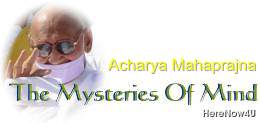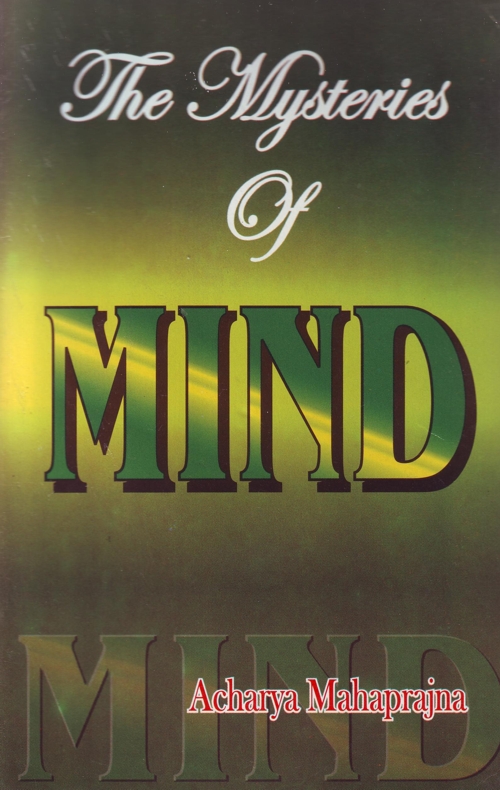
It is necessary to guard ourselves against the agencies, which are instrumental in disturbing and disrupting us. We should avoid indulging in activities, which are habit-forming. It is necessary to be careful in this respect. This is what is called pratyakhyana (renunciation). But it is much more important to be careful about the forces which come from within. It is necessary to purify the depths of our being which contains the upadana or substantial causes of our disturbances. The mere control of instrumental causes does not provide a permanent solution of our problems. The external world will not disappear if we simply closed our eyes. We cannot keep our eyes permanently closed. The eyes are the openings through which the rays of our consciousness pass to enlighten the world outside us. Why should we keep them closed? Why should we stop the activities and functions of the nervous system? Why should we forcibly stop the mind from performing its natural functions?
It is true that the control of instrumental causes gives us temporary relief from the adverse effects they produce in us. But such a measure will not succeed in making us permanently immune from these adverse effects. Our efforts should be directed towards freedom from the adverse effects of the nimitta or instrumental causes of these effects. It will be wholly wrong to make ourselves permanently invalid or paralysed so that all further activity on our part is stopped once for all. Our attempt should be directed towards keeping the sense organs, the nervous system and the brain as healthy and wholesome as to enable them to collaborate with us in our spiritual progress.
Some people out of sheer ignorance take up such spiritual exercises which do them immense harm. Instead of being given to real austerities, they adopt austerities, which are so only in name. They reduce their bodies and render the nervous system so weak that their exertion becomes a retrogressive affair rather than a real spiritual progress.
Austerities in the real sense of the term have the purpose of developing the vital force. There can be no real development of consciousness apart from the development of vital energy. Both must run parallel to each other. The purpose of austerities is not to weaken but to strengthen vital energy. To think of reducing vital energy is a mistake and it must be avoided. Reduced vital energy defeats the very purpose of religion.
We have to keep the centres of vital energy active. The main problem for the practitioner is how to avoid the adverse consequences produced by the instrumental agencies. The way out is the control of the operation of the substantial causes.
Human beings are living a mechanical life today. The invention of computers has proved that man is a mechanical being. Each and every thing which he can do is being done by computers. Computers compose poems, frame questions and answer them. They solve the most complicated mathematical problems, memorize, predict future events, think, offer criticism, perform analyses and distinguish one thing from another.
What is then the difference between man and the machine? The difference is that the human being has a soul, which the machine does not have. And that is also the difference between the living and non-living beings. Mahavira was asked if the soul breathed and he replied that it did not. Then he was asked if the soul thought and he replied that it did not. Then again he was asked if the soul ate and drank and he replied that it did not. Then the question was raised: "How can you say that man has a soul?" If the soul did not do any one of the things mentioned above, no human being can be said to possess a soul. If there were no soul, nobody could practise self-discipline and purify the depths of his being wherein reside the substantial causes of his actions. The mechanical conception will have to be given up. Mechanical activities are of a peripheral nature. They are in no way connected with consciousness. They happen on the outer circles of consciousness. In order to understand the dividing line between living and non living beings, we will have to descend deep into our being where we neither eat nor drink, neither think nor analyse and where we are simply seers and knowers and nothing else. It is there that we will come across the substantial causes of our actions. When we have arrived at this depth our mechanical life comes to an end and we will come face to face with the essence of self-discipline. Self-discipline implies that state of the soul in which it is a spectator and knower par excellence. It is the awareness of this fact, which keeps us self-disciplined. Self-discipline and self-restraint will suffer a set back if we lost this awareness.
There are two theatres of the operation of consciousness: objects of sense-satisfaction and soul-perception and self-knowledge. Consciousness sometimes operates in the first theatre and at other times in the second. During the mechanical process of life, consciousness tries to seek and enjoy objects, which provide sense pleasures. This is the external orientation of consciousness.
The operation of consciousness in its own realm means its being engaged in its own substantial basis or it’s being self-absorbed. It means it’s arriving at the state of self-perception and self-knowledge after breaking through the network of mechanical processes, thinking and breathing. The state of self-perception and self-knowledge is the native operational field of consciousness.
Self-discipline cannot be imposed from outside. Substantially it lies within us. The influence of external things begins to subside as soon as the soul has arrived at its native state. In this state, nothing will be able to influence it. External influences will continue until we have arrived at this state. Man's cravings and his restless tendencies and inclination will attract external influences only so far as he is not himself.
The first principle of the search for self-discipline is to connect consciousness with the state of self-perception and self-knowledge. The second principle is to see with the eyes, hear with the ears, and taste with the tongue without any kind of indulgence and attachments and aversions. It means simple and pure perception with the help of the sense organs. It means perception par excellence unalloyed with likes and dislikes. The first principle implies immunity from all kinds of external influences. The second implies the freedom of consciousness from all kinds of preferences. This becomes possible when we have become embedded in our own substantial nature. Otherwise we shall not be able to train ourselves in self-discipline, which means freedom from attachments.
How to arrive at our substantial nature? What is the technique of arriving at it?
Let us for the time being leave the external influences alone. Let us consider the question whether the responses of the nervous system are genetic or hereditary. The habitual responses of the nervous system can be changed through what is called bhavana in ancient lore and suggestion in psychology. The application of bhavana to bring about changes in the habitual responses of the nervous system has proved to be highly successful. The brain centres connected with the sense organs through a process of suggestions make responses in a controlled manner. First, we should locate the brain-centres connected with particular tendencies and impulses and then through successive suggestions, given in an ordered way, bring about the desired changes in the nervous responses. The tissues connected with knowledge are very delicate, and, therefore, the suggestions should be very carefully and mildly given so that they may be favourably accepted and the desired responses obtained.
There is no sense in repeating sacred formulae. Repetition of formulae can be fruitful only if the repetition is accompanied by bhavana or suggestions. One may go on repeating the formula "This world and the body are transient" for years and years together, but it will produce no effect unless it is accompanied by the mood associated with the transience of the world or unless it acts as a suggestion which brings about the feeling of transience. This feeling or mood has got to be imbibed by one who repeats the formula.
Bhagavan Mahavira coined the word tanmurti. It maybe explained in the following manner. When somebody moves or walks, there are two factors involved in it. One is the person who walks and the other is the movement. Mahavira insisted on removing this duality. The person who walks or moves should not be conscious of the fact that it is he who is moving or walking. He should be wholly and solely absorbed in the act of moving or walking and forget himself. In other words, he should become one with motion and be conscious of nothing else except the rhythm of his movements. This transplantation of consciousness from the ego to the rhythm of motion is called tanmurti. This is one way of arriving at our real (substantial) being.
There is another way, another experiment and that is to become an uncommitted spectator of one's tendencies. Do not try to stop your tendencies and inclinations. Leave them alone. Let the thought processes, whatever their contents, come and go. But instead of indulging in them be a mere spectator of them. The effects of our past actions and experiences accumulated in the subconscious mind must one day or the other find their expression. Let them express themselves. We need not try to repress them. There is no harm in their manifestation. This expression is called vipaka in ancient literature. This vipaka should be watched by us in a disinterested manner like a mere spectator instead of being repressed forcibly. The only thing needed on our part is that we should not indulge in it with any kind of attachment or aversion. Let anger, craving, greed, delusion, murderous thoughts, revenge, etc. rise in your mind freely. But do not associate yourself with them and do not be influenced by them any more. Be neutral and disinterested. Watch them like a spectator watching the scene of a drama. If you could develop such an attitude, it will bring about a great transformation in you. Old habits of the mind will change and a new consciousness, a new orientation of your self will emerge.
Some people ask as to what is achieved by perceiving breath. Breath is not God, and, therefore, why should we contemplate on it? What purpose is served by watching breath? The answer is that watching the breathing-process is not an end in itself, but a means. It is like walking on a rope suspended in the air. It is a risky game, no doubt. At every step there is the danger of falling down on the ground. However, it is an exercise in watchfulness. It is an exercise in keeping the mind alert. Once the mind has become completely trained we will make our performance successful. We will be able to watch our own performance in the same way in which we watch a film on the screen.
There is yet a third way called pratisamli nata or the counteracting of the lures of the sense organs. We shall discuss it later on.
 Acharya Mahaprajna
Acharya Mahaprajna

